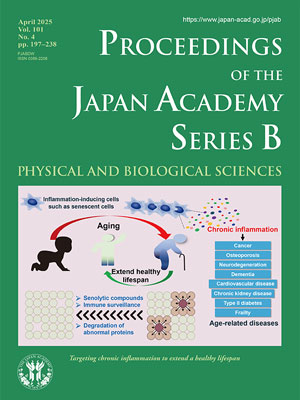About the Cover
Vol. 101 No. 4 (2025)
Although all humans experience a comparable aging process, aging does not appear to be an inevitable phenomenon for all living organisms. For instance, tortoises and naked mole rats raised in highly favorable environments exhibit either very slow aging or no traditional hallmarks of aging. Another intriguing aspect of aging is its role as a major risk factor for numerous human diseases. A study of identical twins revealed that genetic factors contribute only about 20% to the aging process, whereas environmental factors account for approximately 80%. Therefore, a deeper understanding of aging, coupled with the development of effective intervention strategies, holds significant potential for preventing and managing various age-related diseases.
The cover illustration provides a concise representation of the molecular mechanisms underlying age-related diseases, emphasizing chronic inflammation induced by senescent cells and strategies to mitigate this inflammation. In this issue, Dr. Makoto Nakanishi’s review article (pp. 224–237) explores these mechanisms, drawing on recent findings from the author’s research team. The article first discusses p53-dependent senescence induction in relation to cell cycle progression, demonstrating how phase-dependent activation of p53 at the S–G2 transition selectively induces senescence phenotypes through mitotic skipping. The author then examines the intricate mechanisms of DNA methylation replication and how the loss of information from these processes contributes to cellular senescence.
The review also describes the development of mouse models that enable in vivo visualization and analysis of senescent cells. It further discusses the identification of Gls1 inhibitors as senolytic compounds—agents that selectively eliminate senescent cells. The article also highlights the age-dependent accumulation of senescent cells, which is at least partially regulated by PD-1/PD-L1 signaling. Notably, the study demonstrates that the selective elimination of senescent cells and subsequent improvement in age-related diseases can be achieved through the administration of anti-PD-1 antibodies. Finally, the author explores how chronic inflammation contributes to the onset of age-related diseases, including neurodegenerative disorders such as ALS and various cancers.
Although aging is a complex process, uncovering the mechanisms that drive chronic inflammation and developing technologies to suppress it will provide valuable insights into innovative strategies for combating age-related diseases.
Yasuo Kagawa
Professor Emeritus of Jichi Medical University,
Vice-president, Kagawa Nutrition University




